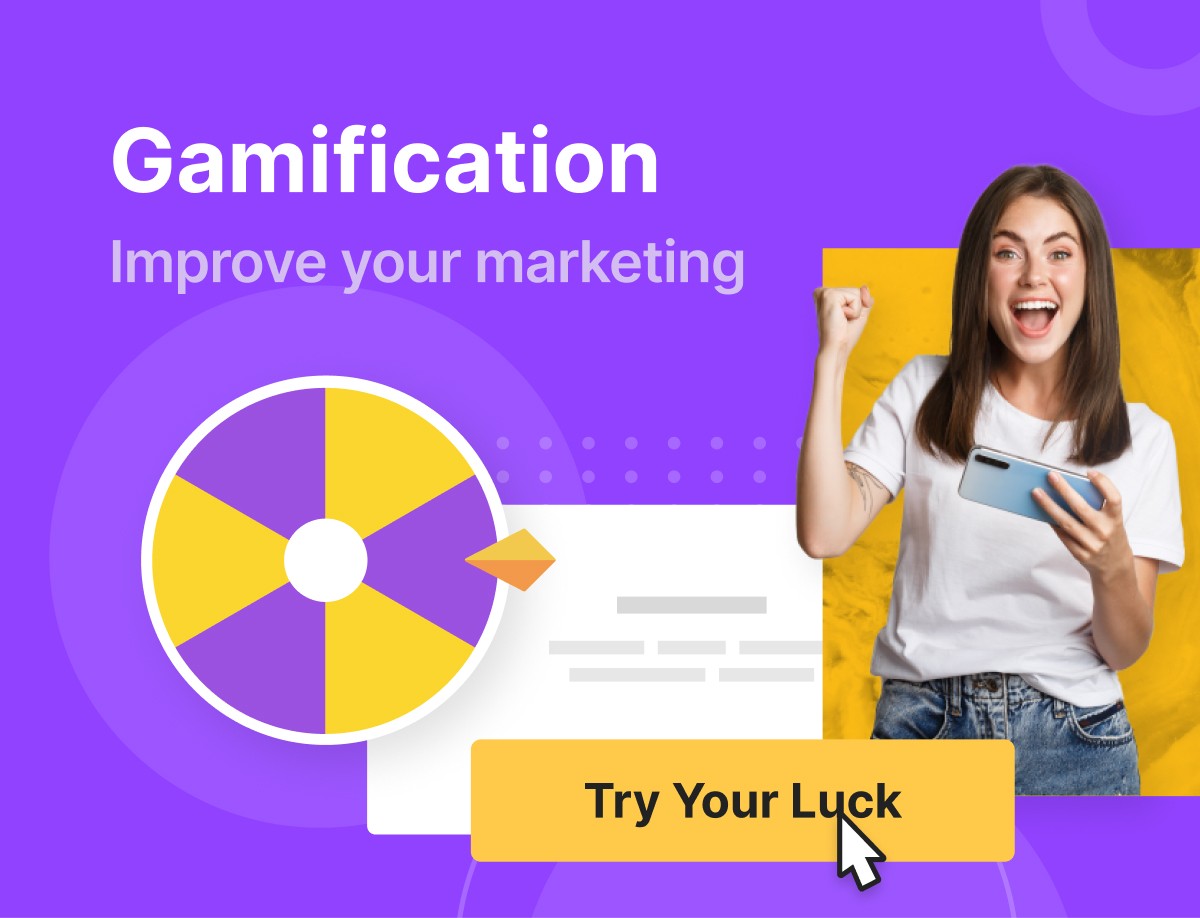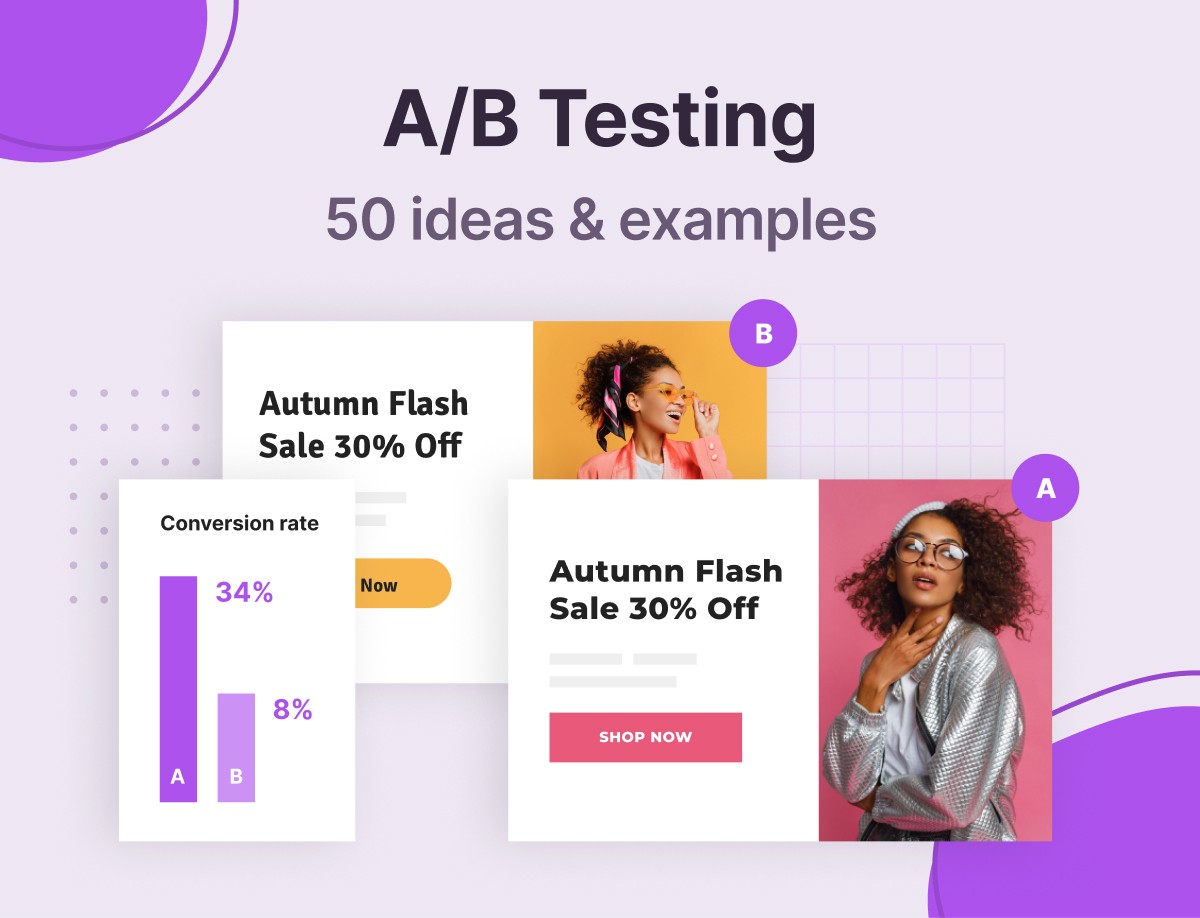Applying gamification in your marketing can help to improve user engagement, drive more conversions and, ultimately, win you more sales.
Simply put, gamification, as the name suggests, is using elements of gaming for marketing, educational, etc. purposes.
More and more companies have used gamification to enhance their employee training method, conduct surveys with their audience, etc.
But in today’s post, we will be looking into how gamification can help win you more conversions and sales.
Content:
- What is gamification
- Benefits of gamification in digital marketing
- 5 best practices for implementing gamification
- Examples of gamification in marketing
- Conclusion
What Is Gamification?


Neil Patel defines gamification as the concept of using game design elements in non-game applications to make them more fun and engaging.
How does this apply to your business?
In this case, your website is a non-game application that you can infuse with game design elements to make it more fun and engaging. These elements could be actual games, leader boards, points, etc.
Gamifying your promotions, for example, could be the game-changer you need to improve your engagement and reduce your bounce rate. With gamification, you can attract customers and make them take action without them even realizing it.
Although putting games and marketing together may seem odd, there’s no other way to make sure your web visitors are having fun while your conversion rates are climbing.
You don’t have to take our word for it. Do you know that gamification has been proven to be effective by several brands including top brands like Coca-Cola, McDonald’s, and Nike?
For example, after creating the gaming app “Pizza Hero” that lets customers create their own Pizza, Domino’s Pizza’s sales revenue increased by 30%.
With that said, let’s now explore, in specific details, the benefits you can get by gamifying your marketing.
Benefits of Gamification in Digital Marketing
You might be wondering if there are any benefits to gamifying your marketing campaign. The short answer is: there are – and they are numerous.
Since it started to become popular in 2010, it has proven to be a strategy that is here to stay.
Perhaps this is because it is a technique that taps into consumer behavior and the innate need people have for fun, adventure, and the deep thrill that comes with wins.
Whether it’s Christmas sales discounts you’re offering or you’re simply doing a clearance sale, you can win more sales with gamification than with any other methods. Let’s see some benefits of gamifying your digital marketing efforts.
Improves User Engagement
Have you ever asked yourself why people- kids and adults alike- like to play games?
One of the obvious reasons is that it’s a very interactive form of entertainment. This is the very reason why gamifying content on your website is an effective way to improve engagement among your audience.
If you’re looking to make your campaign both interactive and engaging at the same time, gamification makes this possible. If you doubt this, think back to the last time you saw a game like this one pop up on a website. It was hard to ignore, right? Right.


This is what happens when your target audience sees gamified content on your website- curiosity gets the better of them and they find it simply hard to resist clicking on it.
If you haven’t already realized it, this means massive awareness for your brand. And this is the first step to getting your desired results from your business.
When people start to get aware of your brand, they are more likely to read your marketing emails, blog posts, refer you to their friends, and generally proceed along the customer journey.
Skyrockets Your Conversion Rates
When your user engagement increases, it is expected that your conversion rates should equally increase. However, this is not always the case.
With gamification, improved engagement leads to high conversion rates if done properly. This is because playing games hardly feel like marketing to your target audience. Therefore, they are more likely to respond to your call to action than if it was a traditional marketing method.
If you have attached rewards to your gamification effort- and you should- your audience will be more encouraged to take actions that drive your conversion rates.
Consider an instance where a user wins a 30% discount from a spin-to-win game on your website. The user won’t see any reason not to proceed to use the discount to make a purchase in your store.
Thus, if you’re not using gamification methods yet, you’re leaving a lot of conversions on the table. But not to worry, we’ve got you covered and will show you how gamification can improve your marketing.
Increases Brand Loyalty
Getting new customers is good. Retaining existing customers is better. Did you know that acquiring new customers can cost five times more than satisfying and retaining current customers?
Now that you know how valuable loyal customers are, next, figure out how to attract and keep them.
The good news is, you don’t have to do too much. Just add gamified content to your website or campaigns.
Gamified content works by using gaming integrations to increase engagement with web users. A good example of gamified content is portrayed by FarmVille.


As your customers interact with them, they’ll find them interesting enough to keep patronizing your brand.
Sometimes, they’ll come back just to keep up their consistent wins. Whether it’s to keep up a winning streak, or for rewards from playing the game, your brand loyalty level increases. And yes, it’s that simple.
When customers interact with your gamified content, they get a sense of familiarity with your brand. When they are ready to make a purchase, they are highly likely to opt for your brand due to this feeling of closeness.
Gamification also gives you the chance to reward your existing customers. They just might turn into advocates of your brand if you do this. You never know, but it’s more than worth the try.
But your existing customers won’t magically become your brand ambassadors. It’s your job to turn them into one, and you have to be intentional about it.
One easy way to go about this is rewarding customers when they make purchases. And the rewards don’t have to be fanciful – something as simple as redeemable points will do.
Gamification Is Functional Across Multiple Platforms
It is no longer news that many people now use devices other than desktop computers or laptops to access the internet.
Are you wondering if gamifying your content will reduce the mobile-friendliness of your website and affect user experience? Well, it won’t, so you have no reason to worry.
Another amazing benefit of gamification is that it can be adapted for different devices. Therefore, it can be used to target both mobile and desktop users alike. So, you have no excuse.
This also means that you can reach a wider audience by gamifying your campaigns. Put this hot marketing strategy to work and watch your marketing performance increase.
Easy Collection of Consumer Data
It would be unwise to spend resources launching campaigns for products or services if you can’t predict the outcomes to an extent. This is where data analytics comes in.
Data helps you tell which campaigns are likely to succeed and which ones are not. It also helps you make the right choices when it comes to what marketing strategies to adopt.
Marketing efforts have a higher chance of succeeding if they are based on data, especially when collected in real-time. This is why there’s so much buzz about data analytics among digital marketers and business owners these days.


The means of getting data is equally important. This is because it has to be accurate to be effective and must be collected without breaking any privacy laws. Enter gamification…If you’re looking for a way to entice your web visitors to give you their personal information, try gamifying some aspects of your websites. You could ask them to provide their information to have their names on a leaderboard, a badge or even to unlock levels of a game.
The fact that these games will run on via an online platform such as your website makes it even easier to collect the information you need- and ethically too.
You can then go ahead to use this data for your marketing and business strategy.
It Is Affordable
Are you just starting your business and are on a tight budget? Even if your pockets run deep, you wouldn’t mind exploring cost-effective marketing strategies to move your business forward, would you?
Don’t be misled by the fancy outlook of most gamification elements. They are not as expensive and time-consuming as they look.
Gamification allows you to save not only money but also the time that you would otherwise spend launching a traditional marketing campaign. With Adoric’s spin-to-win popups, you can have gamified content up and running on your website in no time and with zero knowledge of coding.
Gamified Campaigns Are Not Stopped by AdBlockers
Popups are annoying- they are notorious for interrupting visitors’ browsing experience. Hence, a lot of people use ad blockers. According to Statista, in 2019, roughly 25.8% of internet users were blocking advertisements on their connected devices.
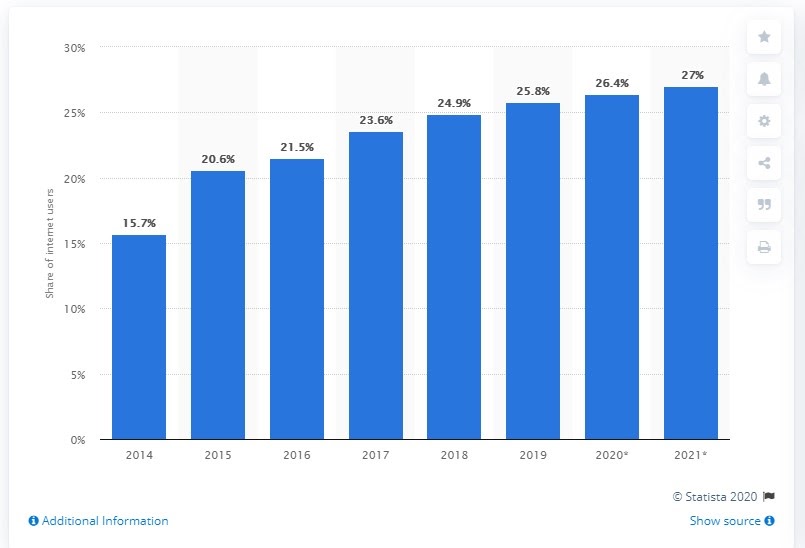

This typically leads to a limited reach with marketing campaigns and a waste of money for many businesses.
According to Gamify, gamified campaigns are not as susceptible to AdBlockers as other ad forms. This is why you shouldn’t hesitate to add it to your marketing arsenal.
5 Best Practices for Implementing Gamification
To reap the benefits of implementing gamification that we just discussed, you’ve got to do it right. Below are best practices for implementing gamification that works:
Keep It Simple
People associate playing games with fun. You don’t want to turn them away by unnecessarily complicating what is supposed to be a fun experience.
If your audience has to spend more time figuring out how your gamified campaign works than they would spend playing it, they might get frustrated and leave your website forever. You don’t want this to happen.
Therefore, you want to avoid this by keeping your gamification design as simple as possible.
Have you ever wondered why game developers first release a basic version of their game and then release subsequent updates? They do this to allow their users to ease into the gaming experience before introducing complexities that may discourage potential gamers at the launch stage.
If your games must have complex parts, borrow a leaf from game developers and wait till it has gotten enough attention from your target audience before adding any complexities.
Understand Your Target Audience
Whatever you do, your target audience should always be your priority. If those who will eventually buy from you are not at the center of your decision making, you can’t expect your efforts to yield results.
You need to ask yourself questions like “what will attract my audience?”, “what do my customers like?”
Don’t get so carried away with your campaign message that you forget to find out how your audience will interpret it. You also don’t want to rush off to implement the latest gamification technique just because it’s fancy. First, make sure your audience can relate with it.
Research your audience. Factors such as gender, location, and age play a huge role when it comes to gamification in sales and marketing.
Answering these questions will help you decide the best gamification technique to implement. Using the right gamification techniques will ensure that your target audience will be receptive to and readily interact with it, thereby fetching you the engagement and high conversion rates you definitely need.
Give Rewards
Would you readily turn down the chance to win a prize, especially when the process involved is a simple one? I guess not. The same applies to your audience.
This means that offering your visitors a chance to win a reward will make them more likely to interact with your gamified campaign.
If you are new to gamification, you can start by rolling out small prizes. It is important to keep your gamification simple so that your audience easily understands how to go about winning the rewards.
Curiosity, they say, killed the cat. Wanna get your users hooked on your game? Make them unnervingly curious.
Get them to anticipate how big the reward they will get for playing your game will be.
For example, if you have a lucky wheel coupon game running on your site, give your users, say, 3 chances to win a prize.
That is to say, they can spin the wheel three times in the hope of winning a big prize.
After each spin, they can redeem their reward or make another attempt. But they can only redeem their prize once, and not three times. Any reward won after a spin is automatically lost if another spin is made.
Getting the idea?
By so doing, you will pique the curiosity of your users and get them hooked on your game.
Encourage Users to Challenge Their Friends
Add options that allow your audience to invite their friend’s to play. Apart from making your gamified content more competitive and interactive, you’d also be expanding your reach.
Add a button that allows users to share their experience on social media together with a clickable link with which they can direct their friends to your site without any hassles.
By doing this, you’d be tapping into the need for humans to compete, win, and be social.
Promote Your Gamified Campaign
Promote…promote..promote!
Promotion is key to the success of any marketing endeavor.
If you are going to reach a wider audience with your gamified content, you just have to go all out in promoting it.
You need to consider the best way to promote your gamified campaign and where you’re most likely to reach your audience. If you’ll be using social media- and you should- you shouldn’t ignore Facebook by any chance, regardless of your industry.
Facebook has a wide range of users, thus, you can reach almost any demographic with your content. It also has features such as business pages and an advertising channel that allows you to advertise with high specificity. This is why Facebook should be on top of your list of social media platforms to market your content on.
You can choose other platforms based on your audience’s behavior and preferences. For example, if yours is an e-commerce store that sells female clothing, apart from Facebook, you would also find your audience on Instagram and Pinterest.
Email marketing is another means you can use to invite your subscribers to participate in your new game.
Promoting your gamified campaign is probably a minor part of gamification but one that you shouldn’t ignore if you want to get the best out of it.
Examples of Gamification In Shopify and Marketing
Apart from marketing, gamification has been applied successfully across other areas, including education and employee performance. So, don’t be alarmed if you hear it used in other contexts.
However, since our focus is on marketing, we have compiled three examples to show you how to apply gamified marketing to your business.
Falling Gift Game: Best Gamification Shopify App
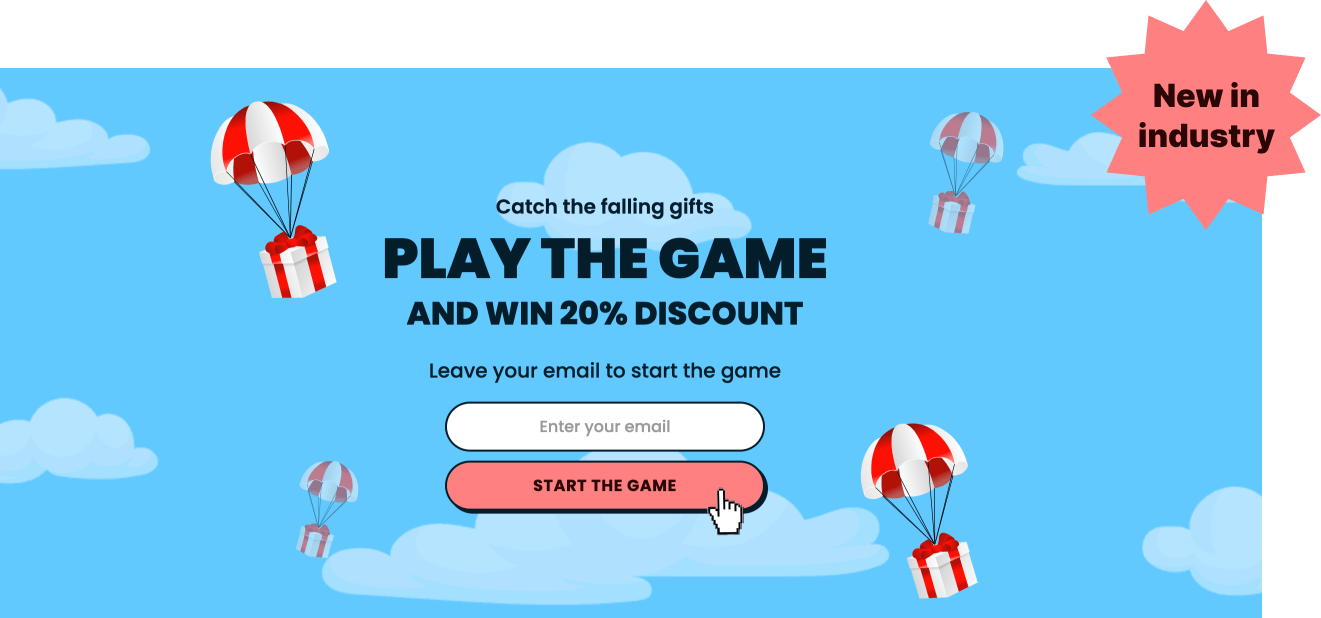

Falling Gift is an innovative technology we developed at Adoric to enable you to gamify your visitors’ browsing experience. This makes Adoric one of the best Shopify gamification apps. How does the Falling Gifts game work?
Well, it’s pretty simple. First, a popup appears moments – typically less than 30 seconds, depending on your settings -after a visitor arrives on your website. It could be a full or half-display popup. On the popup, the user will see balloons falling through and then be asked to input his/her email address (this is where the coupon code will be sent after making a win).
All the user needs to do is click on the falling balloons to reveal the gifts embedded in the balloons. Depending on how you set the system, they might have to attempt several times to win a gift, which is usually a coupon. For now, you can only allow them to try 1 to 6 times.
Setting up the falling gift game is very simple, thanks to our intuitive drag-and-drop editor.
Spin-to-win Coupon Wheels
A spin-to-win coupon wheel is also called a lucky wheel, discount wheel, or wheel of fortune. As the name implies, it’s a gamified wheel you can add to popup campaigns, floating bars, etc.
How does it work?
First, an overview: The spin-to-win wheel rewards users with coupons they can use to shop only on your website.
The user starts the game by entering their email address in the provided space. This is where the coupon won will be sent to.
Then, the instant the user clicks the “spin the wheel” button, the wheel, as you’ve probably guessed, starts to spin.
The spinning stops after a short time with the wheel’s pointer falling on a random value, say 30% off. This means the user has won a 30% discount.
But if the user is unlucky, the pointer falls on “So close”, meaning that they didn’t win anything.
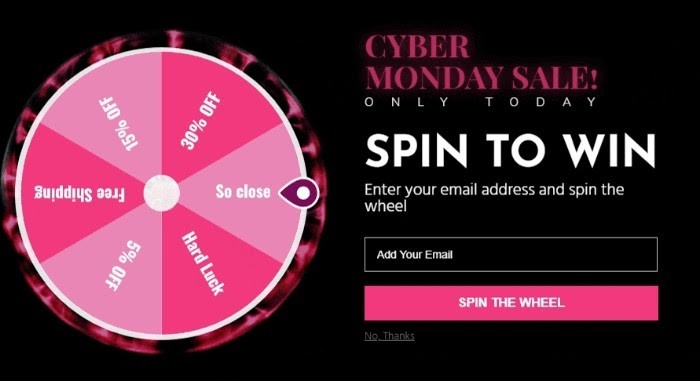

Adding spin-to-win coupon wheels to regular ads like popups, and floating bars adds some excitement to a campaign. You should try it to see how it changes your conversion rates.
They can significantly reduce the rate of cart abandonment in your e-commerce store and generate new leads for your business.
Wondering how to get one done? Not to worry, you don’t need any technical skills, coding knowledge, or lots of time to have one up and running on your website.
Simply sign up on Adoric to make your choice from a huge library of ready-to-use spin-to-win coupon templates in the form of popups, floating bars, and slide-ins.
You can also edit these templates as you like using our drag-and-drop editor. If you’re feeling creative, you can create yours from scratch instead.
Loyalty Reward Programs
One of the best ways to acknowledge your loyal customers is by starting a loyalty rewards program.
Loyalty reward programs are gamified marketing methods that allow a customer to earn points according to the number of purchases they make.
These points are then converted into an incentive after the user has accumulated a specified number of them. This incentive could be discounts on subsequent purchases or freebies.
This strategy encourages the customer to keep buying from the brand. A good example of a company that has successfully pulled this off is Starbucks.
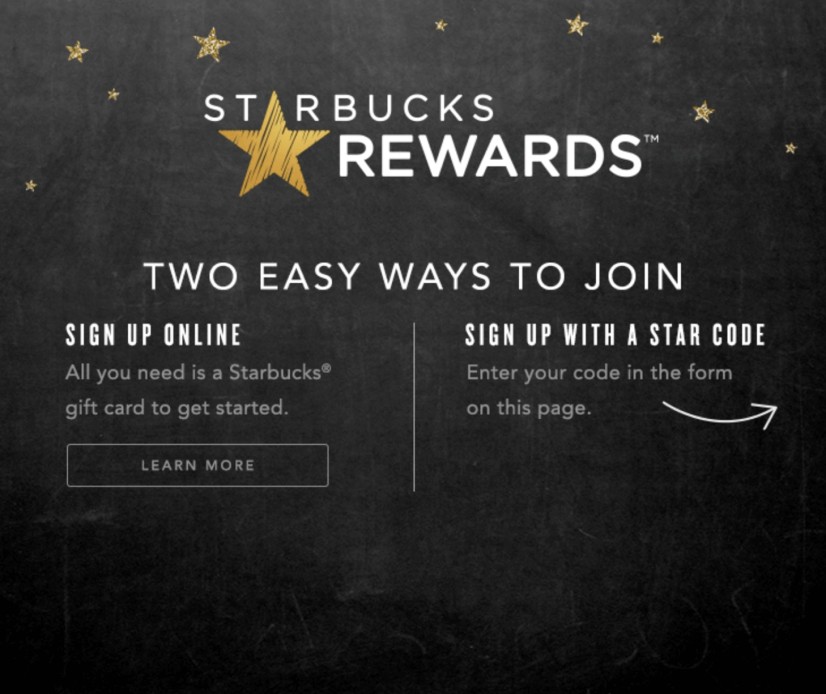

Digital Badges
This is perhaps the most common type of gamification in digital marketing. Businesses award a digital badge to their users as a sign of achievement. In this case, achievement could be finishing a module of a course or making a certain number of purchases.
It’s like winning a trophy, only that this time, it’s a digital one. People find it exciting to collect trophies as they unlock new levels of a challenge.
Depending on your business, the challenge could be proceeding along the customer journey or going through with a course curriculum. A badge is unlocked at certain preset stages and the user can collect them as they proceed.


Badges promote brand loyalty by getting your users to keep coming back to continue from where they stopped with the challenge so that they can earn more badges.
If you decide to opt for digital badges, make sure they have an attractive design that appeals to your audience.
Conclusion
Whatever gamification strategy you choose to adopt, don’t forget that your priority should be making sure that your audience has fun interacting with your gamified content. Rewards are good, but the fun that comes with playing a game is equally important.
We hope you had fun learning about gamification in marketing. If you found this article helpful, do well to share.

